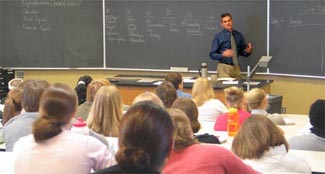Interactive Lectures
What is interactive lecture?
An interactive lecture is an easy way for instructors to intellectually engage and involve students as active participants in a lecture-based class of any size. Interactive lectures are classes in which the instructor breaks the lecture at least once per class to have students participate in an activity that lets them work directly with the material.
- The instructor might begin the interactive segment with an engagement trigger that captures and maintains student attention.
- Then the instructor incorporates an activity that allows students to apply what they have learned or give them a context for upcoming lecture material.
- As the instructor feels more comfortable using interactive techniques he or she might begin to call upon a blend of various interactive techniques all in one class period.
Why use interactive lecture?
Lecturing is a time-honored teaching technique that is an efficient method to present large amounts of content in classes of any size and it is efficient for sharing information with large numbers of students, but may result in students who listen passively.
- Making lectures interactive by including techniques such as think-pair-share, demonstrations, and role playing, can foster active engagement and enhance the value of the lecture segments.
- Using techniques that allow all of the students to participate, instead of having individual students answer questions when called on, will promote student retention and learning of the material presented during lecture, give students practice in developing critical-thinking skills, and enable instructors to assess how well the class is learning that day.
- Breaking up the lecture with these techniques not only provides format change to engage students, these activities allow students to immediately apply content and provides feedback to the instructor on student
How to give an interactive lecture
Giving an interactive lecture involves creating and delivering an effective segmented lecture with engagement triggers and well-selected interactive lecture techniques.
- The instructor must begin by giving attention to pre-instructional planning and various classroom management and logistical issues that allow for modification from the traditional lecture format. Learning goals must be established for interactive lecture techniques, the instructor must determine what types of tasks will be involved and what sort of engagement trigger might be appropriate for the activity (see more about establishing learning goals).
- Next, an interactive lecture technique must be selected and adapted for the specific course and content and attention must be given to how student feedback will be collected. In the most interactive of lectures, the instructor's traditional contributions would be short and the interactive activities could be both planned and spontaneous.
- An effective interactive lecture is likely to call upon a blend of various interactive techniques all in one class period. Additional advice is useful for instructors teaching large enrollment courses.
How to Give an Interactive Lecture
Examples
Instructors can look here to find specific examples of interactive lecture techniques in practice. Examples are cross listed by type of learning structure they employ and by preparation and classroom time required.Examples of Interactive Lecture Techniques
References and Additional Resources
Instructors can look here for a listing of books, articles and website links that offer further explanation of why and how to make your lectures interactive.
References and Additional Resources

